Lamont-Doherty Earth Observatory26
-

Cataloging the Past for Clues to Future Climate Adaptation
A Q&A with archaeologist and anthropologist Kristina Douglass, who studies the evolving relationships between people and the environment.
-

More Frequent Atmospheric Rivers Are Hindering the Recovery of Arctic Sea Ice
Giant trains of warm, moist air are playing havoc with Arctic sea ice during the season when it should be recovering from summer melting.
-

Waters of Long Island Sound: How Local Perspectives Inform Ecological Research
By sharing their day-to-day experiences and deep knowledge of the local environment, fishermen and residents of the Long Island Sound provide crucial information for researchers studying coastal ecosystems health.
-

What Is Blue Carbon and How Can It Help Fight Climate Change?
Researchers at Columbia Climate School discuss the benefits and challenges of working with carbon from ocean and coastal ecosystems.
-

Explorer of Deep Earth Wins Vetlesen Prize
Using sophisticated equipment, David Kohlstedt has recreated the pressure, temperature and chemical conditions in the Earth’s mantle, which humans cannot observe directly. His findings have laid the basis for understanding many of the processes that drive the planet’s dynamics.
-

The Paradox of Lithium
The clean energy transition depends heavily on lithium, but mining this element is not “clean.” We must not fall into the same traps from which we are trying to free ourselves.
-

Flooding in California: What Went Wrong, and What Comes Next
Climate School experts help to explain this devastating weather and what it means in the broader conversation of climate change and disaster response.
-

What Uncertainties Remain in Climate Science?
Climate scientists are still uncertain about a number of phenomena that could affect our future. What are the reasons for this uncertainty?
-

Spring 2023 Student Research Opportunities
The Climate School is offering three new research assistant opportunities during the Spring 2023 semester.

AGU25, the premier Earth and space science conference, takes place December 15-19, 2025 in New Orleans, Louisiana. This year’s theme—Where Science Connects Us—puts in focus how science depends on connection, from the lab to the field to the ballot box. Once again, Lamont-Doherty Earth Observatory and Columbia Climate School scientists, experts, students, and educators are playing an active role, sharing our research and helping shape the future of our planet. #AGU25 Learn More
